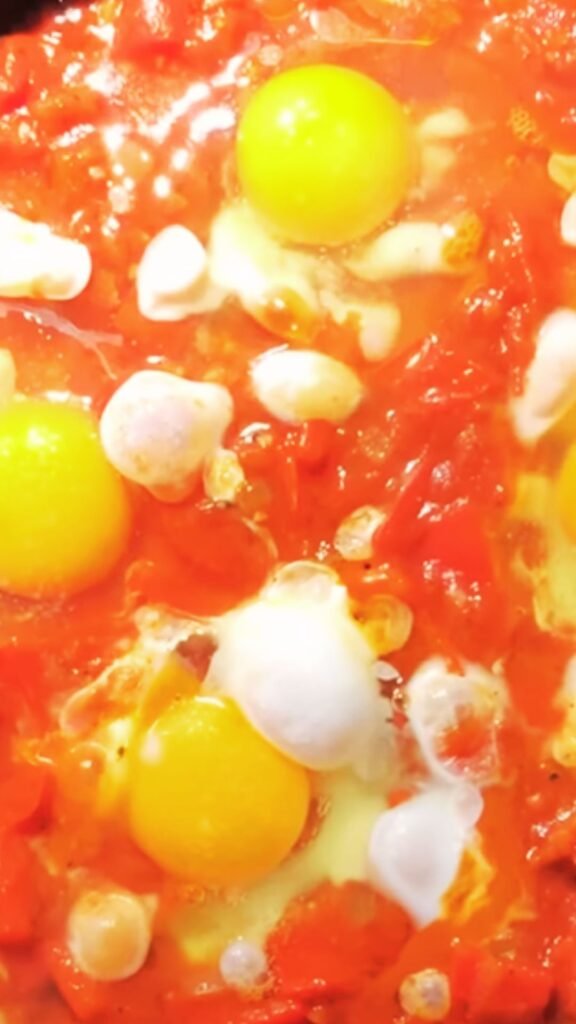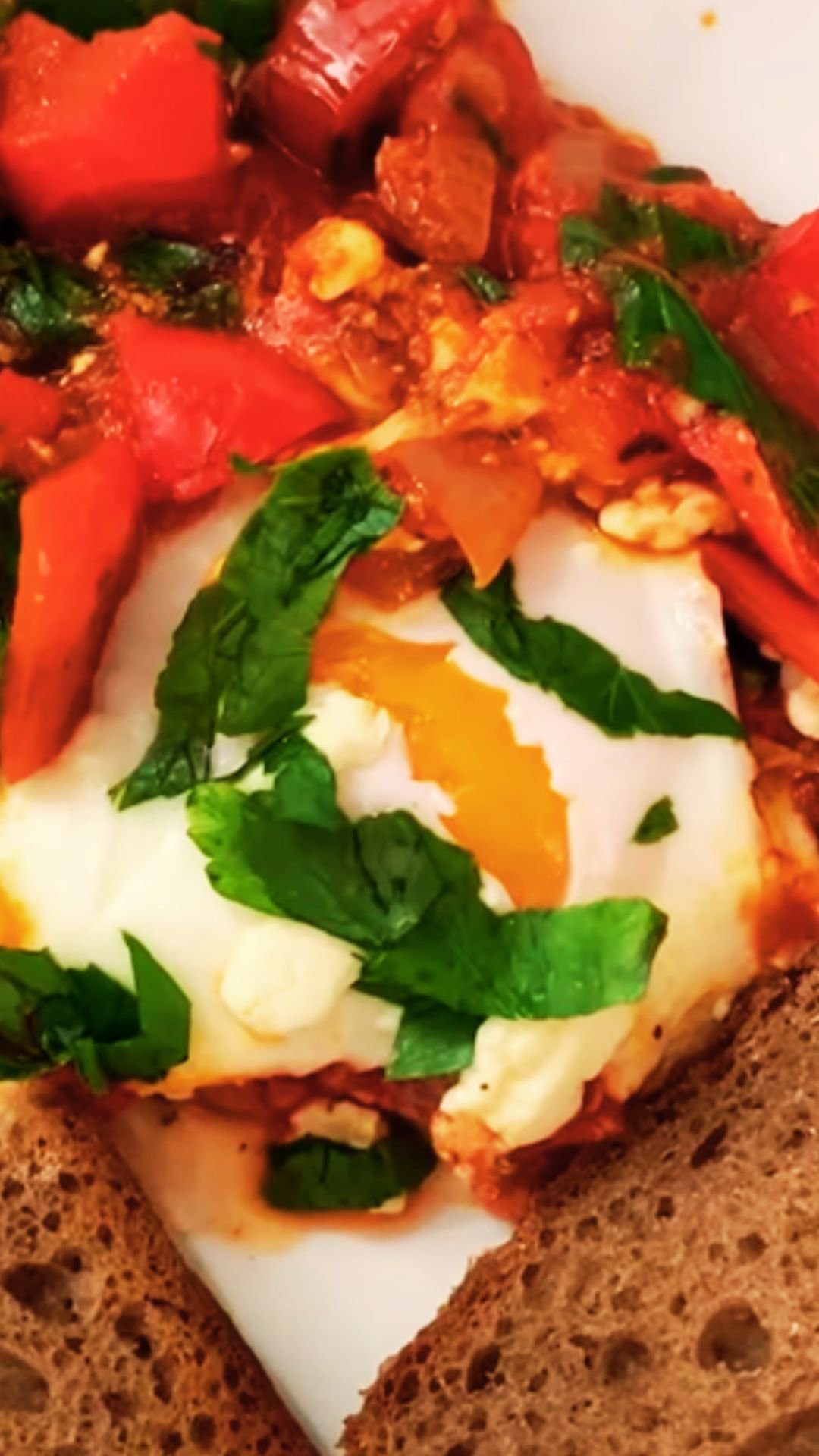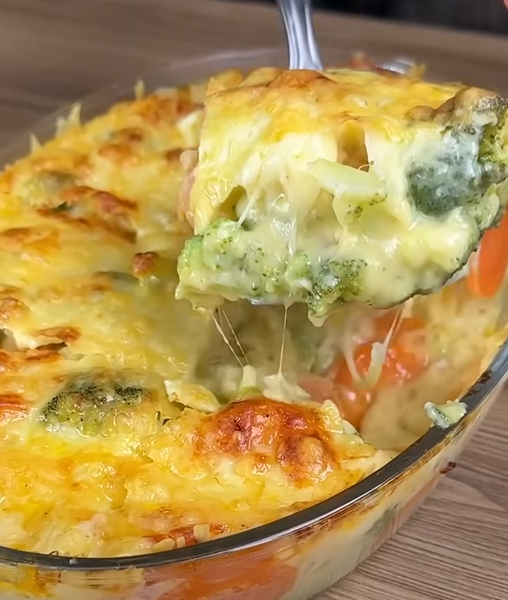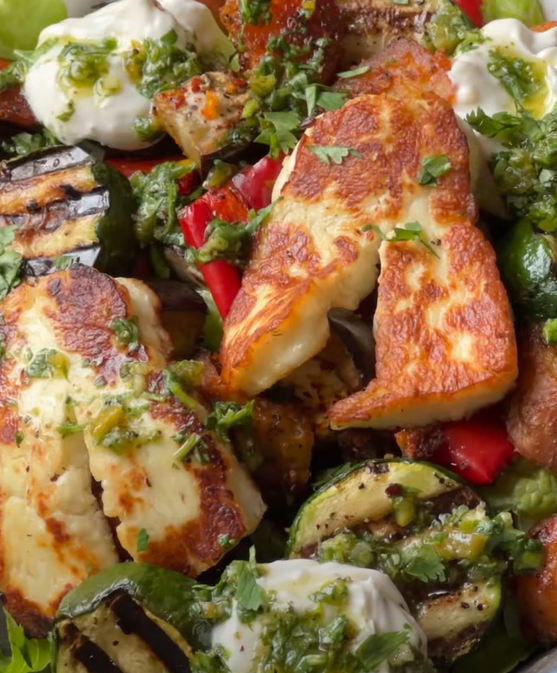Nothing quite captures the essence of comfort food like a perfectly executed shakshuka, and when I discovered how to elevate this classic with creamy feta and a vibrant avocado salad, my weekend brunch routine was forever changed. This isn’t just another recipe variation – it’s a complete meal that bridges the gap between traditional Middle Eastern flavors and fresh Mediterranean ingredients.
I’ve been perfecting this combination for over three years now, and what started as a simple experiment in my kitchen has become the dish my friends specifically request when they visit. The richness of the tomato sauce, the creaminess of perfectly poached eggs, the tangy bite of feta, and the fresh crunch of avocado salad create a symphony of textures and flavors that feels both familiar and excitingly new.
Understanding Shakshuka: More Than Just Eggs in Sauce
Shakshuka – A North African and Middle Eastern dish consisting of eggs poached in a spiced tomato sauce, traditionally served directly from the cooking pan
Feta Integration – The strategic addition of crumbled feta cheese to provide creamy, salty contrast to the acidic tomato base
Avocado Salad Component – A fresh, herb-laden salad that adds cooling elements and textural variety to balance the warm, rich main dish
The beauty of shakshuka lies in its simplicity, but achieving the perfect version requires understanding the balance between acidity, spice, and richness. When I first started making this dish, my sauce was either too watery or too thick, my eggs were overcooked, and the overall flavor profile felt one-dimensional. Through countless iterations, I’ve learned that the secret isn’t just in the ingredients – it’s in the timing, the layering of flavors, and most importantly, knowing when to stop stirring and let the magic happen.
The Science Behind Perfect Shakshuka
Creating exceptional shakshuka isn’t just about following a recipe; it’s about understanding why each element works. The tomato base needs sufficient acidity to properly poach the eggs while maintaining structural integrity. I’ve discovered that using a combination of fresh tomatoes and high-quality canned ones provides the perfect balance of flavor depth and consistency.
The spice blend is where personal preference truly shines. Traditional shakshuka relies heavily on paprika, cumin, and cayenne, but my version incorporates smoked paprika for depth, a touch of coriander for citrusy notes, and just enough harissa paste to add complexity without overwhelming heat.
Ingredient Breakdown: Quality Makes the Difference
| Ingredient Category | Specific Items | Quality Indicators | Storage Tips |
|---|---|---|---|
| Tomato Base | San Marzano canned tomatoes, fresh Roma tomatoes | Deep red color, minimal seeds, firm texture | Store canned at room temperature, fresh tomatoes at counter until ripe |
| Aromatics | Yellow onion, garlic, red bell pepper | Firm texture, no soft spots, vibrant colors | Store onions and garlic in cool, dry place; peppers in refrigerator |
| Spices | Smoked paprika, cumin, coriander, cayenne, harissa | Vibrant color, strong aroma when opened | Store in airtight containers away from light and heat |
| Proteins | Free-range eggs, sheep’s milk feta | Eggs: no cracks, firm whites; Feta: creamy texture, tangy aroma | Refrigerate both, use eggs within 3 weeks, feta within 1 week of opening |
| Fresh Elements | Avocado, cucumber, red onion, parsley, mint | Avocado: slight give when pressed; others: crisp and bright | Store avocados at room temperature until ripe, others refrigerated |
| Finishing Touches | Extra virgin olive oil, lemon, za’atar | Oil: fruity aroma, no rancid smell; Lemon: heavy for size, bright color | Oil in cool, dark place; lemons at room temperature for juicing |
Mastering the Shakshuka Base
The foundation of exceptional shakshuka begins with building layers of flavor. I start by heating my cast iron pan – and yes, cast iron is non-negotiable for this dish. The even heat distribution and retention properties create the perfect environment for gentle egg poaching while maintaining the sauce’s consistency.
My technique begins with slowly caramelizing onions until they’re golden and sweet, which typically takes about 8-10 minutes over medium heat. This patience in the early stages pays dividends in the final flavor profile. I then add minced garlic and diced bell peppers, cooking until the peppers have softened but still retain some texture.
The spice blooming stage is critical and often overlooked. I add my dry spices directly to the softened vegetables and cook for 30-60 seconds until fragrant. This step awakens the essential oils in the spices and prevents them from tasting raw in the finished dish.
The Tomato Transformation Process
Once the aromatics are perfectly developed, I add my tomato mixture – a combination of crushed canned tomatoes and diced fresh ones. The canned tomatoes provide consistent flavor and body, while the fresh ones add brightness and texture. I’ve experimented with ratios extensively, and my preferred blend is 70% canned to 30% fresh.
The sauce needs to simmer and reduce for at least 15-20 minutes. During this time, I resist the urge to constantly stir, instead allowing the bottom to develop slight caramelization that adds depth. The sauce is ready when a wooden spoon dragged across the bottom leaves a clear trail that slowly fills in.
The Art of Egg Poaching in Sauce
Creating wells for the eggs requires finesse. I use the back of a spoon to create depressions in the sauce, ensuring they’re deep enough to contain the eggs but not so deep that the whites spread too thin. The sauce temperature at this point is crucial – it should be at a gentle simmer, not a rolling boil.
I crack each egg into a small bowl first, then gently slide it into its designated well. This technique prevents the yolks from breaking and allows for more controlled placement. The eggs need about 8-12 minutes to reach the perfect consistency where the whites are set but the yolks remain gloriously runny.
Feta Integration: Timing and Technique
The feta addition transforms this dish from excellent to extraordinary, but timing is everything. I crumble the feta directly over the eggs during the last 3-4 minutes of cooking. This allows the cheese to warm through and slightly soften without completely melting and losing its distinct texture.

I prefer using sheep’s milk feta for its creamier texture and more complex flavor profile, though cow’s milk feta works beautifully as well. The key is using high-quality feta that crumbles nicely rather than crumbling into dust or remaining too firm.
Crafting the Perfect Avocado Salad
The avocado salad serves as both a palate cleanser and a textural contrast to the rich shakshuka. My version combines perfectly ripe avocados with crisp cucumber, thinly sliced red onion, and a generous handful of fresh herbs.
Avocado Selection and Preparation
Choosing the right avocados is crucial for this salad. I look for fruits that yield slightly to gentle pressure but aren’t mushy. If my avocados aren’t quite ready, I place them in a paper bag with a banana overnight to speed ripening.
When cutting avocados for this salad, I prefer a medium dice rather than slices. This size holds up better when mixed with the other ingredients and provides the perfect bite-sized portions. To prevent browning, I toss the diced avocado immediately with fresh lemon juice.
Building Flavor Layers in the Salad
| Salad Component | Preparation Method | Flavor Contribution | Textural Element |
|---|---|---|---|
| Avocado | Medium dice, lemon-tossed | Creamy richness, mild nuttiness | Soft, yielding |
| Cucumber | Small dice, salted and drained | Fresh, clean brightness | Crisp snap |
| Red Onion | Paper-thin slices, ice water soaked | Sharp bite, aromatic punch | Tender crunch |
| Fresh Parsley | Rough chop, stems included | Herbaceous freshness, slight pepper | Delicate texture |
| Fresh Mint | Chiffonade cut | Cooling menthol notes, sweetness | Silky smoothness |
| Lemon Zest | Fine microplane grate | Concentrated citrus oils, brightness | Tiny flavor bursts |
The cucumber preparation deserves special attention. I dice the cucumber and lightly salt it, allowing it to drain in a colander for 15 minutes. This draws out excess moisture that would otherwise make the salad watery and dilute the flavors.
For the red onion, I slice it as thinly as possible using a mandoline or very sharp knife, then soak the slices in ice water for 10 minutes. This technique removes the harsh bite while maintaining the onion’s aromatic qualities and crisp texture.
Assembly and Presentation: The Final Act
The presentation of this dish is part of its charm. I serve the shakshuka directly from the cast iron pan, placing it on a wooden trivet to protect the table surface. The avocado salad gets its own bowl, allowing guests to add as much or as little as they prefer.
I like to garnish the shakshuka with additional fresh herbs – usually parsley and a sprinkle of za’atar for its tangy, herbal complexity. A drizzle of high-quality olive oil adds richness and helps the colors pop visually.
Nutritional Profile and Health Benefits
This combination isn’t just delicious; it’s remarkably nutritious. The eggs provide complete proteins and essential fatty acids, while the tomato base delivers lycopene, a powerful antioxidant. The avocado contributes heart-healthy monounsaturated fats, and the fresh herbs add vitamins A, C, and K.
| Nutritional Component | Per Serving (2 eggs) | Health Benefits | Daily Value % |
|---|---|---|---|
| Protein | 18-20g | Muscle maintenance, satiety | 36-40% |
| Healthy Fats | 22-25g | Heart health, nutrient absorption | Varies |
| Fiber | 8-10g | Digestive health, blood sugar control | 28-35% |
| Vitamin C | 45-50mg | Immune support, collagen synthesis | 50-55% |
| Folate | 120-140mcg | Cell division, DNA synthesis | 30-35% |
| Potassium | 800-900mg | Blood pressure regulation, muscle function | 17-19% |
Timing and Meal Planning Strategies
This dish works beautifully for both intimate meals and larger gatherings. For entertaining, I prepare the tomato base up to two days in advance, storing it in the refrigerator and reheating it gently before adding the eggs. The avocado salad components can be prepped the morning of serving, though I wait to cut the avocados until just before assembly.
When serving for a crowd, I use multiple cast iron pans rather than one large pan. This ensures even cooking and allows for different spice preferences – I might make one version milder for those sensitive to heat.
Variations and Adaptations
Over the years, I’ve developed several variations of this basic formula. For a heartier version, I sometimes add crumbled lamb or beef sausage to the tomato base. Vegetarians might enjoy the addition of roasted eggplant or chickpeas for extra protein and substance.
The avocado salad adapts beautifully to seasonal ingredients. In summer, I add diced tomatoes and fresh basil. Fall versions might include pomegranate seeds and toasted pumpkin seeds. Winter adaptations work well with thinly sliced fennel and orange segments.
Troubleshooting Common Issues
Watery sauce: This usually results from not reducing the tomato mixture sufficiently or using tomatoes with too high water content. Solution: Continue simmering uncovered until the sauce thickens, or add tomato paste to help bind excess liquid.
Overcooked eggs: Often caused by sauce temperature being too high or cooking time being too long. Solution: Maintain gentle simmer temperature and check eggs frequently after 8 minutes.
Broken egg yolks: Usually happens when eggs are cracked directly into the pan rather than a bowl first. Solution: Always crack eggs into individual bowls before sliding into the sauce.
Bland flavor profile: Typically results from insufficient spice blooming or not seasoning in layers. Solution: Taste and adjust seasoning at each stage of cooking, ensuring spices are properly activated.
Equipment Recommendations
The right tools make this dish significantly easier to execute perfectly. My must-have equipment includes:
- 10-12 inch cast iron skillet: Essential for even heat distribution and attractive presentation
- Wooden spoon: Won’t scratch the pan surface and doesn’t conduct heat
- Small bowls for eggs: Allows for controlled egg addition
- Sharp knife: Critical for uniform vegetable cuts
- Box grater: For fresh cheese crumbling
- Citrus zester: For lemon zest in the salad
Serving Suggestions and Accompaniments
This dish pairs beautifully with warm, crusty bread for scooping up the sauce. I prefer a rustic sourdough or pita bread warmed in the oven. For a complete meal, consider adding:
- Labneh or Greek yogurt on the side
- Pickled vegetables for acidity
- Olives for additional Mediterranean flavors
- Fresh fruit for a sweet finish
Storage and Reheating Guidelines
Leftover shakshuka base keeps well in the refrigerator for up to three days, though the eggs won’t reheat perfectly. I often make extra sauce intentionally, using it later in the week as a pasta sauce or pizza base.
The avocado salad doesn’t store well due to the avocado’s tendency to brown and become mushy. If I must prepare it in advance, I keep all components separate and assemble just before serving.
Questions and Answers
Q: Can I make shakshuka without eggs for a vegan version? I’ve successfully created vegan versions by substituting crumbled firm tofu or white beans for the eggs. The tofu works particularly well when seasoned with nutritional yeast and turmeric for color. Simply add it during the last 5 minutes of cooking to warm through.
Q: What’s the best way to prevent the feta from becoming too salty? I always taste my feta before adding it to gauge saltiness levels. If it’s particularly salty, I’ll rinse it briefly under cold water and pat dry before crumbling. Also, remember that feta will concentrate in flavor as it warms, so start with less than you think you need.
Q: How can I make this dish spicier without overwhelming the other flavors? I prefer building heat gradually through layers rather than adding one intensely hot element. Try increasing the harissa paste, adding a pinch more cayenne, or including fresh jalapeños with the bell peppers. Hot sauce on the side allows individual heat preferences.
Q: Can I use different types of cheese instead of feta? Absolutely! Goat cheese works beautifully and provides similar tanginess with a creamier texture. Fresh mozzarella adds richness without competing flavors, while aged cheeses like Parmesan contribute nutty complexity. Avoid processed cheeses that don’t hold up well to heat.
Q: What’s the secret to getting perfectly runny egg yolks every time? Temperature control is key – maintain a gentle simmer, not a rolling boil. I also prefer using room temperature eggs as they cook more evenly than cold ones straight from the refrigerator. Start checking doneness at 8 minutes by gently touching the whites.
Q: How do I keep avocados from browning in the salad? Immediate acid treatment is crucial – toss cut avocados with lemon juice within 30 seconds of cutting. I also store any prepared salad with plastic wrap pressed directly onto the surface to minimize air exposure. Adding the avocados last, just before serving, is always the safest approach.
Q: Can I prepare components ahead for entertaining? The tomato base actually improves when made a day ahead, allowing flavors to meld. I store it refrigerated and reheat gently before adding eggs. The salad vegetables can be prepped and stored separately, but wait to cut avocados and dress the salad until serving time.
Q: What should I do if my sauce is too acidic? A pinch of sugar can help balance excessive acidity from tomatoes. I prefer using a small amount of tomato paste, which adds body while mellowing sharp edges. Sometimes a splash of cream or a bit more feta can provide richness that balances acidity naturally.
This shakshuka with feta and avocado salad has become more than just a recipe in my kitchen – it’s a celebration of how simple ingredients, when treated with respect and combined thoughtfully, can create something truly memorable. The combination of warm, comforting shakshuka with cool, fresh avocado salad provides the perfect balance for any meal, whether you’re hosting friends or treating yourself to a special weekend brunch.
The beauty of this dish lies not just in its flavors, but in its adaptability and the joy it brings to the table. Each time I make it, I’m reminded of why cooking is such a rewarding pursuit – it’s about more than just feeding ourselves; it’s about creating experiences, memories, and moments of pure satisfaction that linger long after the last bite.


